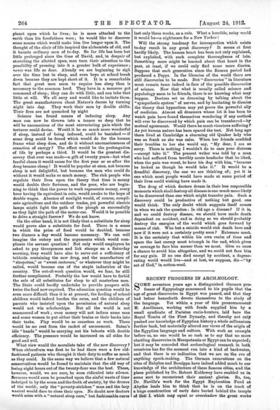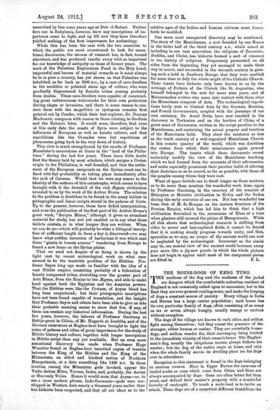RECENT PROGRESS IN ARCHEOLOGY.
SOME seventeen years ago a distinguished German pro- fessor of Egyptology announced to his pupils that the age of great discoveries in Egypt was passed, and that they had better henceforth devote themselves to the study of the language. Yet within a year of this pronouncement M. Amelineau, working with funds supplied him by a small syndicate of Parisian curio-hunters, laid bare the Royal Tombs of the First Dynasty, and thereby not only pushed our knowledge of Egyptian history a whole millennium further back, but materially altered our views of the origin of the Egyptian language and culture. With such an example before us, no one would be so rash as to say that no more startling discoveries in Mesopotamia or Egypt can be expected; but it may be conceded that archaeological research in both countries has for the moment run into a kind of backwater, and that there is no indication that we are on the eve of anything epoch-making. The German excavations on the, sites of Babylon and Borsippa have indeed added much to our knowledge of the architecture of these famous cities, and the plans published by Dr. Robert Koldewey have enabled us in some sort to reconstruct their ancient glories. So, too, Dr. Naville's work for the Egypt Exploration Fund at Abydos leads him to think that he is on the track of a huge construction of early date buried behind the temple of Seti L which may equal or overshadow the great works
unearthed by him some years ago at Deir el-Babari. Neither here nor in Babylonia, however, have any inscriptions of im- portance come to light, and up till now they have therefore yielded nothing of the first importance for archaeology.
While this has been the case with the two countries to which the public are most accustomed to look for sensa- tional discoveries, the stream of research has, in fact, turned elsewhere, and has produced results every whit as important for our knowledge of antiquity as those of former years. The work of the Palestine Exploration Fund in the Holy Land, ungrateful and barren of material rewards as it must always be in so poor a country, has yet shown us that Palestine was inhabited, as far back as 3000 B.C., by a race of cave-dwellers in the neolithic or polished stone age of culture, who were gradually dispossessed by Semitic tribes coming probably from Arabia. These cave-dwellers were capable of construct- ing great subterranean waterworks for their own protection during sieges or invasions, and there is some reason to con- nect them with the megalithic or cyclopean remains first pointed out by Conder, which their last explorer, Dr. Duncan Mackenzie, compares with reason to those existing in Sardinia and the Balearic Isles. It would seem, therefore, that even at this early date the coasts of Syria were subject to the influences of. European as well as Asiatic culture, and that expeditions like the Crusades were but repetitions of phenomena going back to the very dawn of history.
This view is much strengthened by the results of Professor Macalister's excavations at Gezer in the "land of the Philis- tines " during the last few years. These leave little doubt that the theory held by most scholars, which assigns a Cretan origin to the Philistines, is well founded, and that the settle- ment of the European emigrants on the Syrian coast can be fixed with fair probability as taking place immediately after the sack of Cnossos. Would that we were any nearer to the identity of the authors of this catastrophe, which seems to have brought with it the downfall of the rich .gear civilization revealed to us by the work of Sir Arthur Evans. The solution to the problem is doubtless to be found in the many tablets in pictographic and linear scripts stored in the palaces of Crete. Up to the present, however, these have defied interpretation, and even the publication of the first part of Sir Arthur Evans's great work, " Scripta Minoa," although it gives us abundant material for study, has not yet enabled us to say what these tablets contain, or in what tongue they are written. When we can do so—which will probably be when a bilingual inscrip- tion of sufficient length to form a key is discovered—we may know what sudden incursion of barbarians it was which sent these " giants in brazen armour " wandering from Europe to found a new home on the Syrian plains.
That we need not despair of so doing is shown by the light cast by recent archmological work on what once seemed to be the insoluble problem of the Hittites. Pro- fessor Sayce long ago made us familiar with the idea of a vast Hittite empire, consisting probably of a federation of loosely compacted tribes, stretching over the greater part of Asia Minor, from the Euxine to the 2Egean, and able to make head against both the Egyptian and the Assyrian powers. That the Hittites were, like the Cretans, of Aryan blood has long been conjectured ; but their pictographic inscriptions have not been found capable of translation, and the insight that Professor Sayce and others have been able to give us into their probable meaning seems to show that few, if any, of them can contain any historical information. During the last few years, however, the labours of Professor Garstang at Saktje-geuzi in Cilicia, of Mr. Hogarth at Jerabliis, and of the German excavators at Boghaz-keui have brought to light the ruins of palaces and cities of great importance for the study of Hittite history and culture, together with longer inscriptions in Hittite script than any yet available. But an even more sensational discovery was made when Professor Hugo Wiuckler found at Boghaz-keui inscribed copies of treaties between the King of the Hittites and the King of the Mitannians, an allied and kindred nation of Northern Mesopotamia, at a date something like 1400 B.C. In these treaties, among the Mitannian gods invoked, appear the Vedic deities Mitra, Varuna, Indra, and, probably, the Asvins or Heavenly Twins. Hence it would seem that Aryan—or, to use a more modern phrase, Indo-Germanic—gods were wor- shipped in Western Asia nearly a thousand years earlier than hai hitherto been suspected, and that all our ideas as to the relative ages of the Indian and Iranian cultures must hence- forth be modified.
One more most unexpected discovery may be mentioned. The story of the Manichaaans, a sect founded by one Manes in the latter half of the third century A.D., which aimed at including in one vast syncretism the religions of Zoroaster, Buddha, and Christ, has hitherto formed a sort of romance in the history of religions. Desperately persecuted on all sides from the beginning, they yet managed to make their way in secret, and succeeded in the eleventh century in gain- ing such a hold in Southern Europe that they were enabled for some time to defy the whole might of the Catholic Church. Their tenets have hitherto only been known to us by the writings of Fathers of the Church like St. Augustine, who himself belonged to the sect for some nine years, and of Mohammedan writers who came into contact with them after the Mussnlman conquest of Asia. The archaeological expedi- tions lately sent to Central Asia by the German, Russian, and French Governments, coupled with the journeys of our own emissary, Dr. Aurel Stein, have now resulted in the discovery in Turkestan and on the borders of China of a great mass of documents, written in the script peculiar to the Manichmans, and containing the actual prayers and treatises of the Manicha3an faith. They show the existence as late as the tenth century of a well-organized Manieha3an Church in this remote quarter of the world, which was doubtless the centre from which their missionaries again poured into Europe. The tenets which these documents reveal materially modify the view of the Manichman teaching which we had formed from the accounts of their adversaries, and make especially prominent their peculiar habit of altering their doctrines so as to accord, as far as possible, with those of the peoples among whom they were cast.
Want of space forbids one to dwell longer on these matters, or to do more than mention the wonderful work done, again by Professor Garstang, in the recovery of the remains of Ethiopian or Meroitic civilization in Nubia and the Sudan during the early centuries of our era. Not less wonderful has been that of M. de Morgan on the eastern frontiers of the Persian Empire, which has led him to think that a high civilization flourished in the mountains of Elam at a time when glaciers still covered the plains of Mesopotamia. While all this shows that archaeological research is shifting from older to newer and less-explored fields, it cannot be denied that it is making steady progress towards unity, and that, specialize as we may, no corner of the ancient world can now be neglected by the archaeologist. Irreverent as the simile may be, our mental view of the ancient world becomes every year more like a jig-saw puzzle in which the whole picture does not begin to appear until moat of the component pieces



































 Previous page
Previous page